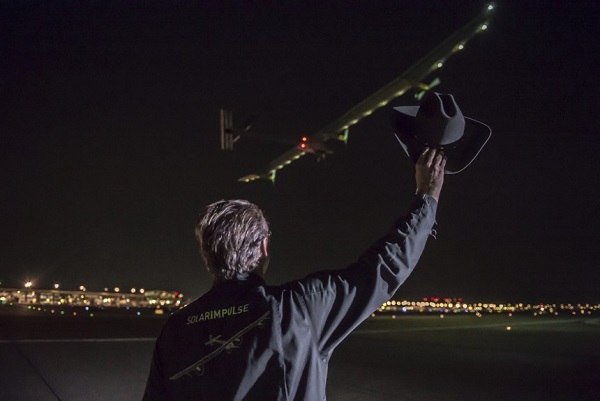UPDATE: Solar Impulse landed safely in St. Louis at 1:27 a.m. CDT on Tuesday morning, approximately 21 hours and 20 minutes after taking off from Dallas/Fort Worth. “I feel coming back from another world … a world of flying solar,” an exultant pilot Bertrand Piccard said when asked how he felt soon after Solar Impulse rolled to a stop on the Lambert-St. Louis International Airport tarmac.
As recent events have shown, late spring can bring treacherous conditions to the middle of the United States, the area that has earned the nickname “Tornado Alley.” So when the weather gods gave the sun-powered Solar Impulse airplane an opening to get out of Texas and head to St. Louis, the team pounced.
The plane left Dallas/Fort Worth International Airport at 4:06 a.m. CDT Monday morning on what was expected to be a 21-hour flight to St. Louis, where in another era in aviation history local businessmen financed the Spirit of St. Louis airplane that Charles Lindbergh would fly across the Atlantic.

This is the third leg of the record-breaking solar airplane’s cross-country journey. It began on May 3 in Silicon Valley, heading for Phoenix, then took off for Texas on May 22. A stop in Washington, D.C., will come after St. Louis, and the trip will conclude in New York. Fans can follow Solar Impulse’s progress live on the Internet.
The willowy, 3,500-pound plane, with a 208-foot wingspan, is made of lightweight carbon fiber materials. It has 12,000 solar cells built into its wing which recharge a set of four 400-kilo lithium batteries. The plane averages about eight horsepower—similar to what the Wright Brothers managed when they first flew in 1903.
So light and moving so slowly, the plane needs just the right weather window to safely make its fuel-free way across the skies. The plane is doing public outreach in each of the city it is visiting, but in Phoenix there was an extra week of waiting before the weather window opened.
Just a few days ago, on Friday, the St. Louis area was hit by tornados – even as the Solar Impulse team was eyeing the possibility of good flying conditions for the following Monday. The storms damaged the plane’s prospective hanger at Lambert-St. Louis International Airport, raising the possibility of delaying the flight. The team was loathe to wait, however, “as the particularly difficult weather conditions in the region leave only very few flight possibilities between Dallas-Fort Worth and St. Louis, and it might be the only one this week,” the team said in a statement.
So to protect the plane on the ground in St. Louis, an inflatable hangar will be deployed. “Conceived and designed by the Solar Impulse team for the world tour of 2015, this revolutionary structure will be used for the very first time in real conditions,” the Solar Impulse team said. “The team will only have a few hours to deploy this innovative structure before the airplane arrives.” Here’s a video of how the hangar works provided by Solar Impulse:
Bertrand Piccard was piloting the team to St. Louis (he’s and André Borschberg have alternated legs), and no doubt he and the whole team will be well-received in the city that so identifies itself with historic flight.
During the Monday flight, Piccard spoke with Erik Lindbergh, the grandson of Charles Lindbergh and a man saluted by Piccard as “one of the first patrons of Solar Impulse.”
Piccard noted that when Charles Lindbergh flew from New York to Paris, he did it solo – a plane at that time was not capable of carrying passengers on such a long flight. “Twenty years later, all the airplanes were transporting dozen or hundreds of passengers,” Piccard said.
“With Solar Impulse today, we are a little bit in the same situation,” Piccard went on. “We can fly with one single pilot on board, no passengers.… And people will say, like in 1927, ‘It will be impossible to do more.’ I have no idea how soon there will be passengers in solar airplanes but what is very clear is that today, if we don’t aim like Solar Impulse at flying day and night, we could already have solar airplanes flying in the middle of the day with two, three, or four people on board and I hope the industry will soon understand the potential of this.”